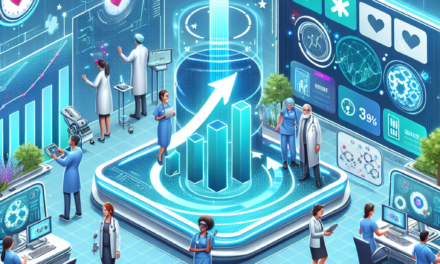The Rise of Smart Hospitals: Enhancing Patient Care Through Innovation
In recent years, the healthcare industry has witnessed a transformative shift towards the integration of technology in patient care. This evolution has given rise to the concept of “smart hospitals,” which leverage advanced technologies to enhance patient outcomes, streamline operations, and improve overall healthcare delivery. This article delves into the various facets of smart hospitals, exploring how innovation is reshaping patient care and the healthcare landscape as a whole.
1. Understanding Smart Hospitals
Smart hospitals are healthcare facilities that utilize cutting-edge technologies to create a more efficient, patient-centered environment. These hospitals integrate Internet of Things (IoT) devices, artificial intelligence (AI), big data analytics, and telemedicine to improve patient care and operational efficiency. The goal is to create a seamless experience for patients, healthcare providers, and administrative staff.
Key characteristics of smart hospitals include:
- Real-time data monitoring and analytics
- Automated processes and workflows
- Enhanced communication systems
- Patient engagement tools
- Telehealth capabilities
By harnessing these technologies, smart hospitals can provide personalized care, reduce wait times, and improve patient satisfaction. The integration of smart technologies also allows for better resource management, ultimately leading to cost savings for healthcare providers.
2. The Role of IoT in Smart Hospitals
The Internet of Things (IoT) plays a pivotal role in the development of smart hospitals. IoT devices, such as wearable health monitors, smart beds, and connected medical equipment, enable real-time data collection and analysis. This data can be used to monitor patient health, track vital signs, and manage hospital resources more effectively.
For instance, smart beds equipped with sensors can automatically adjust their position based on a patient’s needs, reducing the risk of pressure ulcers and improving comfort. These beds can also alert nursing staff if a patient attempts to get up, ensuring timely assistance and preventing falls.
Moreover, IoT devices can facilitate remote patient monitoring, allowing healthcare providers to track patients’ health from the comfort of their homes. This capability is particularly beneficial for managing chronic conditions, as it enables timely interventions and reduces the need for hospital visits.
Case Study: The implementation of IoT in hospitals has shown promising results. For example, the Mount Sinai Health System in New York has integrated IoT devices to monitor patients with chronic obstructive pulmonary disease (COPD). By using connected devices, healthcare providers can track patients’ symptoms and medication adherence, leading to a significant reduction in hospital readmissions.
3. Artificial Intelligence and Machine Learning in Patient Care
Artificial intelligence (AI) and machine learning (ML) are revolutionizing patient care in smart hospitals. These technologies can analyze vast amounts of data to identify patterns, predict outcomes, and assist healthcare providers in making informed decisions.
AI algorithms can be used for various applications, including:
- Predictive analytics for patient outcomes
- Automated diagnosis and treatment recommendations
- Natural language processing for clinical documentation
- Robotic process automation for administrative tasks
For example, AI-powered diagnostic tools can analyze medical images, such as X-rays and MRIs, to detect abnormalities with high accuracy. This not only speeds up the diagnostic process but also reduces the likelihood of human error.
Case Study: The use of AI in radiology has been exemplified by the partnership between Google Health and various healthcare institutions. Their AI algorithms have demonstrated the ability to outperform human radiologists in detecting breast cancer in mammograms, showcasing the potential of AI to enhance diagnostic accuracy and improve patient outcomes.
4. Telemedicine: Bridging the Gap in Patient Care
Telemedicine has emerged as a crucial component of smart hospitals, especially in the wake of the COVID-19 pandemic. By enabling remote consultations and monitoring, telemedicine has made healthcare more accessible to patients, particularly those in rural or underserved areas.
Smart hospitals utilize telemedicine platforms to:
- Facilitate virtual consultations between patients and healthcare providers
- Monitor patients’ health remotely through connected devices
- Provide access to specialists without the need for travel
- Enhance patient education and engagement through digital resources
The convenience of telemedicine not only improves patient satisfaction but also reduces the burden on healthcare facilities. Patients can receive timely care without the need for in-person visits, which is particularly beneficial for managing chronic conditions or follow-up appointments.
Case Study: The Cleveland Clinic has successfully implemented telemedicine services, allowing patients to consult with specialists from the comfort of their homes. During the pandemic, the clinic reported a significant increase in telehealth visits, demonstrating the effectiveness of this approach in maintaining continuity of care.
5. The Future of Smart Hospitals: Challenges and Opportunities
While the rise of smart hospitals presents numerous opportunities for enhancing patient care, it also comes with challenges that must be addressed. Key challenges include:
- Data privacy and security concerns
- Integration of disparate systems and technologies
- High implementation costs
- Need for staff training and adaptation
Data privacy is a significant concern, as the increased use of connected devices and digital platforms raises the risk of data breaches. Healthcare organizations must implement robust cybersecurity measures to protect patient information and comply with regulations such as HIPAA.
Integration of various technologies can also be challenging, as many hospitals still rely on legacy systems that may not be compatible with newer solutions. A strategic approach to technology adoption is essential to ensure seamless interoperability and maximize the benefits of smart hospital initiatives.
Despite these challenges, the future of smart hospitals looks promising. As technology continues to evolve, we can expect further advancements in patient care, operational efficiency, and overall healthcare delivery. The ongoing investment in research and development will likely lead to innovative solutions that address current limitations and enhance the capabilities of smart hospitals.
Conclusion
The rise of smart hospitals represents a significant advancement in the healthcare industry, driven by innovation and technology. By leveraging IoT, AI, telemedicine, and other cutting-edge solutions, these hospitals are enhancing patient care, improving operational efficiency, and transforming the overall healthcare experience.
As we move forward, it is crucial for healthcare organizations to embrace these technologies while addressing the associated challenges. By doing so, they can create a more patient-centered, efficient, and effective healthcare system that meets the needs of patients and providers alike.
In summary, the integration of smart technologies in hospitals is not just a trend; it is a necessary evolution in healthcare. The potential benefits are immense, and as we continue to explore and implement these innovations, we can look forward to a future where patient care is more personalized, accessible, and effective than ever before.





